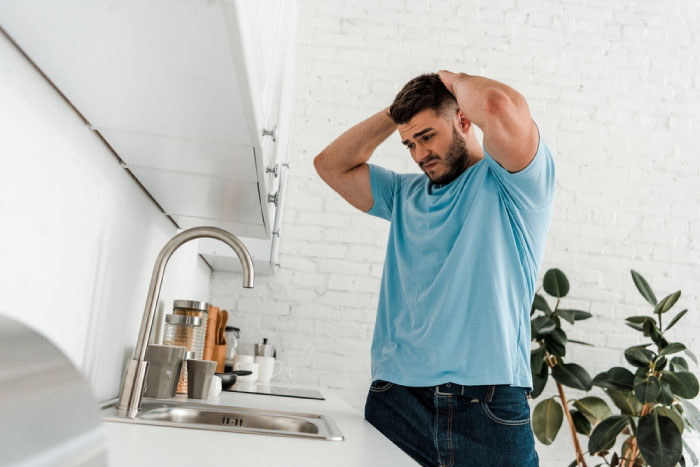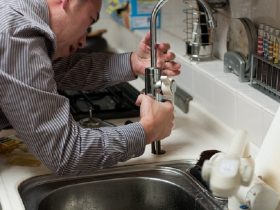There are many things in our daily lives we take for granted. One of those things is the often-overlooked kitchen sink.
We use it to wash dishes, produce, and food preparation, rarely giving it a second thought. Yet, stress and frustration quickly emerge when a sink stops working.
So what is the problem that makes a sink stop working? A problem that can make a sink stop working includes a clogged drain, a faulty faucet, or low water pressure.
When a sink problem emerges, it could be anything from an easy fix to a costly problem. Here, we’ll explore the main ways sinks stop working, the reasons, and the possible solutions.
Read more:
1. 6 Essential Winter Plumbing Tips
2. Avoid These 10 Common Mistakes and Maximize the Benefits of Your Rainwater Tank
3. 8 Common Plumbing Problems You Experience & What You Can Do About It
4. 5 Pesky Plumbing Problems & How To Tackle Them
5. Plumbing Problem Crossword Clue & All Possible Answers To It
The Three Main Reasons a Sink Stops Working and How to Fix Them
When faced with a sink that doesn’t work, it is easy to assume it will involve a costly repair. However, a malfunctioning sink needn’t be a catastrophe.
With a little patience and the good ol’ process of elimination, you can find the solution to your issue.
1. Clogged Drain
When water does not drain or your sink begins to make gurgling sounds, it means something is restricting the flow of water.
Food waste, grease, and oil are the main reasons a kitchen sink stops draining water. A broken or inefficient garbage disposal can also be the reason if it does not break down food particles properly.
To fix a slow-draining or clogged sink, try the following solutions.
Run Boiling Water
Pour boiling water directly down the drain to loosen grease and food blockages. To see if it worked, turn on the faucet and see how the water drains. Repeat one more time if needed.
DO NOT try this method if you have PVC pipes since the plastic can melt or become damaged with boiling water.
Check the Garbage Disposal
Sometimes, simply turning on the garbage disposal will break the blockage.
A low humming sound could mean it is jammed. However, if the garbage disposal does not turn on, it may be overheated or malfunctioning.
Try rebooting the garbage disposal by pressing the reset switch typically located on the side or bottom of the appliance.
If that does not work, you may have to break the clog manually. NEVER stick your hand into a garbage disposal and ALWAYS unplug it before working on it.
Use an Allen wrench, or something similar, to turn the blades to break the clog. Once you feel less resistance, turn the power back on, and run the water faucet.
If water still doesn’t drain properly, try another solution.
Try a Plunger
Use a plunger dedicated solely for kitchen use, preferably the flat-bottom type.
Fill the sink half-way with hot water. Place the plunger over the drain and pump quickly. Remove it and see if the water drains.
Try this a few times. If the water still doesn’t drain, move on the another fix.
Vinegar and Baking Soda Mixture
This is a great, natural alternative to using chemicals that could damage your pipes.
Remove any standing water from the sink and pour one cup of baking soda, followed by one cup of white vinegar. Allow the mixture to sit, covered for approximately 15 minutes.
Remove the cover and run hot water (use boiling water for more stubborn clogs) down the drain. Repeat a couple of times.
Snake It!
Stubborn blockages typically require a plumber’s snake, which is a corkscrew tool that reaches down the drain.
When a manual snake reaches the clog, you simply crank the handle to move the blockage around and pull it out.
Beware when using the snake, however, as pushing it too hard may move the debris further down the pipe, making it more difficult to retrieve.
Electric snakes have more power and are typically used for serious back-ups.
When you remove the blockage, run hot water down the drain to ensure you got it all.
Clean that P-Trap!
The p-trap is an elbow-shaped pipe located under the sink where food, grease, and other gunk can become stuck.
To unclog, you will have to disassemble the pipe and clean it out. Things can get messy, so be sure to use gloves, eye protection, towels, and a bucket to place underneath the pipe.
You will need to unscrew the connectors to remove the p-trap. Once you clean it, reassemble the pipe and run hot water to test for proper drainage.
2. Faucet Issues
Leaky faucets or clogged faucets are another issue that can keep a sink from working.
Leaky faucets can be the result of an old or worn-out washer or O-ring in the faucet that needs replacing.
However, if there is no water coming out of the faucet, the following could explain why.
Water Supply Valves
Most sinks have one or two water supply valves underneath the sink, one for hot water and one for cold water.
Sometimes these valves can get bumped when moving or getting items from the sink cabinet. Check these valves when neither the hot nor cold water is running.
An open valve has a lever that is parallel to the water pipe. A closed valve has a lever that is perpendicular to the water pipe.
Clogged Supply Valve
If the water valves are open but water is still not flowing, then they may be clogged with debris.
Turn off the water supply line and disconnect it from the faucet. Point it to a bucket and slowly turn the water back on.
If water still isn’t flowing, then the valve is clogged and needs to be replaced.
Clogged Aerator
The faucet aerator is a small mesh screen at the faucet’s spigot. Hard water mineral deposits and debris can clog the aerator.
To check, unscrew the spout and remove the mesh. Soak it in white vinegar for about 30 minutes, then scrub it with an old toothbrush.
If cleaning it doesn’t work, simply replace the aerator.
Frozen Pipes
In cold climates, water lines can freeze during the winter and prevent water from flowing.
To unfreeze, open a faucet to ease the pressure and place a space heater in the room to thaw the pipes gradually.
Once the pipes are thawed, check for leaks as the frozen water can cause extensive damage.
Smart Faucets
Since smart faucets operate via sensors, a nonfunctioning one is often the cause of a lack of water flow.
Try resetting the appliance or replacing the batteries if the faucet is not working.
3. Water Pressure Issues
Oftentimes, the issue is not a lack of water, but sudden low water pressure. This can be caused by the following:
Max Flow Cylinder
Some faucets can control the maximum water flow with a max flow cylinder installed on the spout inlet just under the sink.
When clogged, it slows the flow of water through the faucet. Look for a small, short cylinder inside the hose connected to the spout or in the spout inlet.
Remove it and soak it in white vinegar for 30 minutes. Scrub with an old toothbrush, rinse and replace it.
Pressure-Balance Valve
If you notice that the hot and cold water in several fixtures close to each other has low or spotty water pressure, then this valve may be worn down or clogged.
To fix the water flow issue, find and replace the valve. It should be a dome-shaped brass fitting, usually located inside the house, past the main shut-off valve. It can also be found on the fixtures themselves.
Final Thoughts on Reasons a Sink Stops Working
When a sink stops working, it can cause frustration and stress. Knowing the ways sinks stop working, the reasons and potential solutions can go a long way in saving you time, money, and headaches.
What is a 4 letters crossword clue for a problem that makes a sink stop working?
A problem that makes a sink stop working is a clog. In crossword puzzles, ‘clog‘ is a common 4-letter answer to clues related to plumbing issues or blocked drains.











Leave a Review